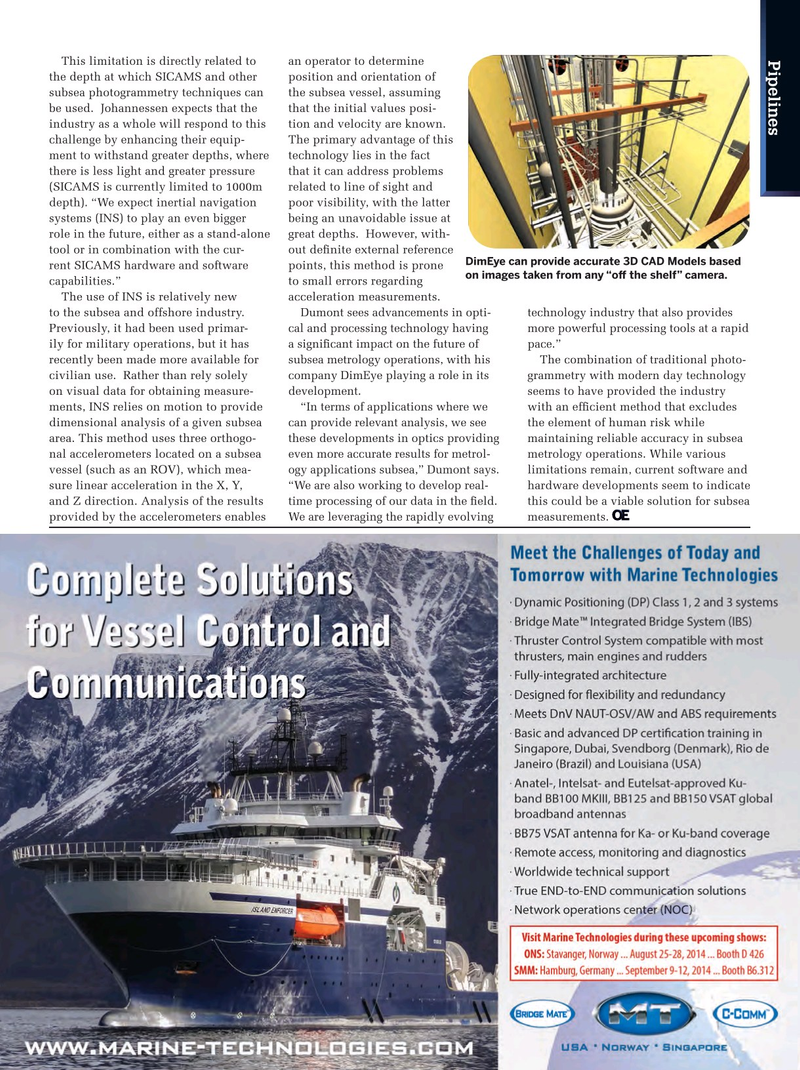
Page 59: of Offshore Engineer Magazine (Jun/Jul 2014)
Read this page in Pdf, Flash or Html5 edition of Jun/Jul 2014 Offshore Engineer Magazine
Pipelines
This limitation is directly related to an operator to determine the depth at which SICAMS and other position and orientation of subsea photogrammetry techniques can the subsea vessel, assuming be used. Johannessen expects that the that the initial values posi- tion and velocity are known. industry as a whole will respond to this
The primary advantage of this challenge by enhancing their equip- technology lies in the fact ment to withstand greater depths, where that it can address problems there is less light and greater pressure related to line of sight and (SICAMS is currently limited to 1000m poor visibility, with the latter depth). “We expect inertial navigation being an unavoidable issue at systems (INS) to play an even bigger great depths. However, with- role in the future, either as a stand-alone out defnite external reference tool or in combination with the cur-
DimEye can provide accurate 3D CAD Models based points, this method is prone rent SICAMS hardware and software on images taken from any “of the shelf” camera.
to small errors regarding capabilities.”
The use of INS is relatively new acceleration measurements.
Dumont sees advancements in opti- technology industry that also provides to the subsea and offshore industry. cal and processing technology having more powerful processing tools at a rapid
Previously, it had been used primar- a signifcant impact on the future of pace.” ily for military operations, but it has subsea metrology operations, with his The combination of traditional photo- recently been made more available for civilian use. Rather than rely solely company DimEye playing a role in its grammetry with modern day technology on visual data for obtaining measure- development. seems to have provided the industry ments, INS relies on motion to provide “In terms of applications where we with an effcient method that excludes dimensional analysis of a given subsea can provide relevant analysis, we see the element of human risk while area. This method uses three orthogo- these developments in optics providing maintaining reliable accuracy in subsea nal accelerometers located on a subsea even more accurate results for metrol- metrology operations. While various vessel (such as an ROV), which mea- ogy applications subsea,” Dumont says. limitations remain, current software and sure linear acceleration in the X, Y, “We are also working to develop real- hardware developments seem to indicate and Z direction. Analysis of the results time processing of our data in the feld. this could be a viable solution for subsea provided by the accelerometers enables
We are leveraging the rapidly evolving measurements. 058_OE0614_Pipelines2_Greg.indd 61 5/22/14 10:44 PM

 58
58

 60
60